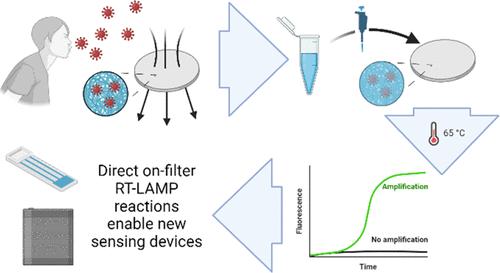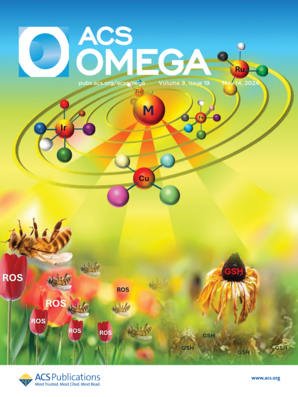优化反转录环路介导等温扩增技术,在微空气过滤装置中原位检测 SARS-CoV-2
IF 3.7
3区 化学
Q2 CHEMISTRY, MULTIDISCIPLINARY
引用次数: 0
摘要
2019 年冠状病毒病(COVID-19)大流行推动了分子诊断领域的创新,并促使人们探索可自主识别空气传播传染病病原体的系统。空气传播病毒检测是确定暴露风险的一种新兴方法,但目前的方法限制了干预的及时性。在此,我们探讨了反转录环介导等温扩增(RT-LAMP)测定法,该测定法可在适用于空气传播病毒微过滤的膜过滤器上运行,对严重急性呼吸系统综合征冠状病毒 2(SARS-CoV-2)(SCV2)进行一次性检测。我们使用实验设计统计框架来确定在膜过滤器上运行 RT-LAMP 的最佳添加剂成分。通过 SCV2 液体加标实验和荧光检测,我们发现玻璃纤维过滤器上的单锅 RT-LAMP 每次反应(3600 个 E 基因拷贝)能可靠地检测到 0.10 50% 组织培养感染剂量(TCID50)的 SCV2,其灵敏度比传统 RT-LAMP 高一个数量级。本文章由计算机程序翻译,如有差异,请以英文原文为准。

Optimization of Reverse Transcription Loop-Mediated Isothermal Amplification for In Situ Detection of SARS-CoV-2 in a Micro-Air-Filtration Device Format
The Coronavirus disease 2019 (COVID-19) pandemic has supercharged innovation in the field of molecular diagnostics and led to the exploration of systems that permit the autonomous identification of airborne infectious agents. Airborne virus detection is an emerging approach for determining exposure risk, although current methods limit intervention timeliness. Here, we explore reverse transcription loop-mediated isothermal amplification (RT-LAMP) assays for one-pot detection of Severe acute respiratory syndrome Coronavirus 2 (SARS-CoV-2) (SCV2) run on membrane filters suitable for micro-air-filtration of airborne viruses. We use a design of experiments statistical framework to establish the optimal additive composition for running RT-LAMP on membrane filters. Using SCV2 liquid spike-in experiments and fluorescence detection, we show that single-pot RT-LAMP on glass fiber filters reliably detected 0.10 50% tissue culture infectious dose (TCID50) SCV2 per reaction (3600 E-gene copies) and is an order of magnitude more sensitive than conventional RT-LAMP.
求助全文
通过发布文献求助,成功后即可免费获取论文全文。
去求助
来源期刊

ACS Omega
Chemical Engineering-General Chemical Engineering
CiteScore
6.60
自引率
4.90%
发文量
3945
审稿时长
2.4 months
期刊介绍:
ACS Omega is an open-access global publication for scientific articles that describe new findings in chemistry and interfacing areas of science, without any perceived evaluation of immediate impact.
 求助内容:
求助内容: 应助结果提醒方式:
应助结果提醒方式:


